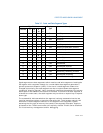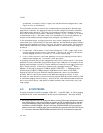
Vol. 3 4-3
PAGING
linear addresses larger than 32 bits, 32-bit paging and PAE paging translate 32-bit
linear addresses.
Because it is used only if IA32_EFER.LME = 1, IA-32e paging is used only in IA-32e
mode. (In fact, it is the use of IA-32e paging that defines IA-32e mode.) IA-32e
mode has two sub-modes:
• Compatibility mode. This mode uses only 32-bit linear addresses. IA-32e paging
treats bits 47:32 of such an address as all 0.
• 64-bit mode. While this mode produces 64-bit linear addresses, the processor
ensures that bits 63:47 of such an address are identical.
1
IA-32e paging does not
use bits 63:48 of such addresses.
4.1.2 Paging-Mode Enabling
If CR0.PG = 1, a logical processor is in one of three paging modes, depending on the
values of CR4.PAE and IA32_EFER.LME. Figure 4-1 illustrates how software can
Table 4-1. Properties of Different Paging Modes
Paging
Mode
CR0.PG CR4.PAE
LME in
IA32_EFER
Linear-
Address
Width
Physical-
Address
Width
1
Page
Size(s)
Supports
Execute-
Disable?
None 0 N/A N/A 32 32 N/A No
32-bit 1 0 0
2
32 Up to 40
3
4-KByte
4-MByte
4
No
PAE 1 1 0 32 Up to 52
4-KByte
2-MByte
Yes
5
IA-32e 1 1 2 48 Up to 52
4-KByte
2-MByte
Yes
5
NOTES:
1. The physical-address width is always bounded by MAXPHYADDR; see Section 4.1.4.
2. The processor ensures that IA32_EFER.LME must be 0 if CR0.PG = 1 and CR4.PAE = 0.
3. 32-bit paging supports physical-address widths of more than 32 bits only for 4-MByte pages and
only if the PSE-36 mechanism is supported; see Section 4.1.4 and Section 4.3.
4. 4-MByte pages are used with 32-bit paging only if CR4.PSE = 1; see Section 4.3.
5. Execute-disable access rights are applied only if IA32_EFER.NXE = 1; see Section 4.6.
1. Such an address is called canonical. Use of a non-canonical linear address in 64-bit mode pro-
duces a general-protection exception (#GP(0)); the processor does not attempt to translate non-
canonical linear addresses using IA-32e paging.


















